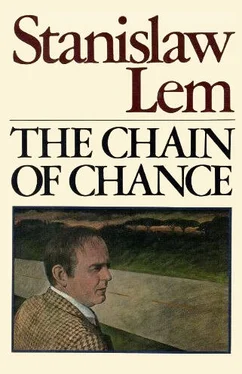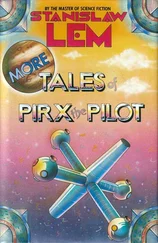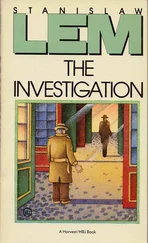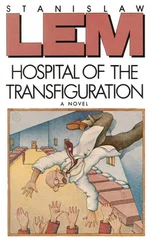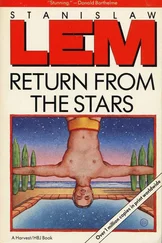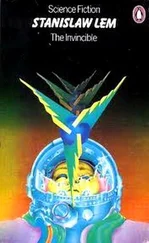Stanislaw Lem - The Chain of Chance
Здесь есть возможность читать онлайн «Stanislaw Lem - The Chain of Chance» весь текст электронной книги совершенно бесплатно (целиком полную версию без сокращений). В некоторых случаях можно слушать аудио, скачать через торрент в формате fb2 и присутствует краткое содержание. Город: New York, ISBN: , Издательство: Harcourt Brace Jovanovich, Жанр: Фантастика и фэнтези, на английском языке. Описание произведения, (предисловие) а так же отзывы посетителей доступны на портале библиотеки ЛибКат.
- Название:The Chain of Chance
- Автор:
- Издательство:Harcourt Brace Jovanovich
- Жанр:
- Год:неизвестен
- Город:New York
- ISBN:9780151165896
- Рейтинг книги:3 / 5. Голосов: 1
-
Избранное:Добавить в избранное
- Отзывы:
-
Ваша оценка:
- 60
- 1
- 2
- 3
- 4
- 5
The Chain of Chance: краткое содержание, описание и аннотация
Предлагаем к чтению аннотацию, описание, краткое содержание или предисловие (зависит от того, что написал сам автор книги «The Chain of Chance»). Если вы не нашли необходимую информацию о книге — напишите в комментариях, мы постараемся отыскать её.
The Chain of Chance — читать онлайн бесплатно полную книгу (весь текст) целиком
Ниже представлен текст книги, разбитый по страницам. Система сохранения места последней прочитанной страницы, позволяет с удобством читать онлайн бесплатно книгу «The Chain of Chance», без необходимости каждый раз заново искать на чём Вы остановились. Поставьте закладку, и сможете в любой момент перейти на страницу, на которой закончили чтение.
Интервал:
Закладка:
Proque also fell into the trap, but by a different route. Though he had never had any need of the scalp ointment, gone to the beach, or taken mineral baths, the sulfur ions entered his circulation through inhalation of sulfur dioxide from hypo used in developing photos; the Ritalin came from the stimulant prescribed for his lethargy; and the compound X, from Dr. Dunant’s glasses. All the time the learned and patient doctor was busy running tests on every scrap, every speck of dust inside Proque’s shop, taking specimens of the plywood partition and the grinding powder, little did he realize that the mystery substance was located approximately four meters above his head—in a bag of sugar-coated almonds lying at the bottom of a dresser drawer.
What had alerted Barth’s chemists and provided them with the missing link were the almonds found with my notes on the table.
One incidental though rather amusing detail: after my return to the States, I was told by a chemist friend of mine that the flowers of sulfur sprinkled in my bed by little Pierre could not have acted as a chemical agent, for the reason that elemental sulfur, obtained as a solid through sublimation, is monionic and insoluble in water. My friend came up with the hypothesis that the ionic sulfur found in my blood must have come from wine that had been allowed to sulfurize. Following the French custom, I was in the habit of drinking wine with every meal; this last time, however, I had drunk exclusively at Barth’s place, since I never ate any meals out. The chemists from the CNRS must have been aware of this but preferred not to embarrass their boss by insinuating he was serving his guests bad wine.
I was later asked whether the almonds had been my great discovery. Nothing would have been easier than to give a yes or no answer, but the truth was I didn’t know. During my rampage, when I’d gone around destroying everything within reach, dumping everything that seemed lethal into the bathtub, I had certainly acted like a madman, but in this madness of mine there was an element of self-preservation. It might have been similar with the almonds. I’d wanted to make a note of them, that much I know, though this reflex of mine could have been the result of many years of practice. I had been trained to record things under conditions of maximum stress, to assess the relevance of something regardless of my own personal opinion. It might have been just a flash of intuition that led me to connect the thunderstorm, my sneezing fit, the pill stuck in my throat, the almonds, and the image of Proque making that last trip into the corner candy store on Rue Amélie. But that strikes me as too good to be true. I might have associated the almonds with the Naples affair at the sight of the miniature Vesuvius displayed in the shopwindow. Though not directly related to the case, Vesuvius turned out to be the magic link that put me on the right trail. Though if you look back carefully over my report, you will see there were many times during the investigation when I thought I was on the right trail, and yet nothing came of it. Barth was on the right track, too, though he was wrong in suspecting a political motive. He was right in questioning the method of selection—the “group of eleven”—and also in saying the victims included only unmarried foreigners because the latter were more apt to be isolated from their Italian surroundings by their unfamiliarity with the language and the absence of any dependents. The first sign of a toxic reaction was always a change in disposition, which only someone close to the victim would have been able to detect in the early stages. Subsequent investigation revealed several “abortive cases” involving Italians and foreigners who had come to Naples with their wives. In every case the pattern was identical: alarmed by her husband’s erratic behavior, the wife would start to keep a closer eye on him, and the moment he started having hallucinations she would do her utmost to persuade him to leave the country. This impulse to return home was an instinctive reaction in the face of an unknown danger. The Italians, on the other hand, would immediately be put under a psychiatrist’s care—usually under family pressure—at which time they would be advised to stop driving, to discontinue the Plimasine, and to interrupt their bathing treatment; as a result of this abrupt change, the symptoms would rapidly disappear. A chance circumstance kept the investigation from uncovering these “abortive cases” earlier. In each and every instance someone from the victim’s immediate family would come to claim the prepaid subscription, but since the books of the various spas recorded only the financial transactions, and not the reason for the cancellation, there was absolutely no way the persons in question could be traced.
There were a number of other factors impeding the investigation. No one likes to brag about using an ointment as a preventive against baldness. Those who made no fuss about going bald, or who preferred wearing a wig to using an ointment, escaped unharmed, though there was no way investigators could know this at the time. Those who avoided the hormone had no reason to testify, since they were safe and sound, while those who did use it died. No packages containing the Swiss ointment were ever found among the victims’ personal belongings because the medication was supposed to be kept stored in the refrigerator. This was easy enough to do at home, but not in a hotel, so rather than take the medication along with them on their travels, the more conscientious among the older men would rely on the local barbers. The directions called for one application every ten days, which meant that only one application was needed during the time spent in Naples. And of course during the investigation it never occurred to anyone to canvass the local barbershops to find out what they were rubbing into the scalps of certain customers.
And lastly, just as all the victims shared a definite physical resemblance, so, too, they all had certain psychological traits in common. All were men well past their prime, still very conscious of their appearance, struggling with old age but reluctant to admit it. Those men who were already in their sixties and completely bald had given up trying to look younger than their age and had stopped shopping around for miraculous cures, whereas those who were thirty and had grown prematurely bald were not likely to require any bathing treatment for advanced rheumatism. Therefore the ones who were exposed to the greatest danger were those who had already crossed the shadow line. In retrospect, the more closely one examined the facts, the more interrelated they became. For example, the chemical poisonings all took place during the blooming season, when drivers were more apt to use Plimasine, and since patients with acute asthma were physically unable to drive, they would have had no need for a drag intended for drivers.
Barth was gracious enough to keep me company during my stay in the hospital, so I decided to pay him a farewell visit before flying back to the States. Pierre was keeping a lookout by the stairs but ducked out of sight the moment he saw me coming. I knew what was on his mind and promised him I wouldn’t forget about his helmet. Barth had another visitor, Dr. Saussure, now wearing a shirt with frilled cuffs instead of a frock coat, with a pocket watch dangling from his neck instead of a calculator. While he browsed through some books in the library, Barth spoke to me about one of the supreme ironies of the case: even though it had been inoperative and unprogrammed the whole time, the computer had proved enormously beneficial to the investigation. Because if I hadn’t flown to Paris with the idea of using the computer, I never would have stayed at Barth’s place, never would have aroused the sympathy of his grandmother, and little Pierre never would have come to my rescue with the flowers of sulfur after my fall on the stairs… In short, the computer played an undisputed role in unraveling the mystery, though in a purely abstract sort of way. With a laugh I commented that the whole combination of fortuitous events leading up to the solving of the mystery now seemed to me more amazing than the mystery itself.
Читать дальшеИнтервал:
Закладка:
Похожие книги на «The Chain of Chance»
Представляем Вашему вниманию похожие книги на «The Chain of Chance» списком для выбора. Мы отобрали схожую по названию и смыслу литературу в надежде предоставить читателям больше вариантов отыскать новые, интересные, ещё непрочитанные произведения.
Обсуждение, отзывы о книге «The Chain of Chance» и просто собственные мнения читателей. Оставьте ваши комментарии, напишите, что Вы думаете о произведении, его смысле или главных героях. Укажите что конкретно понравилось, а что нет, и почему Вы так считаете.
